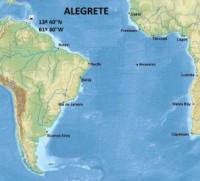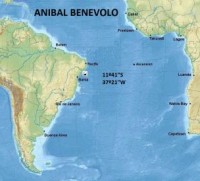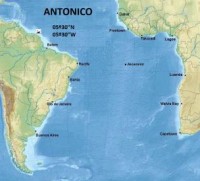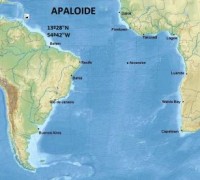SHIPS HIT BRAZIL 33 - BRAZILIAN SHIPS LOST
2)AFFONSO PENNA (IT SUB BARBARIGO)
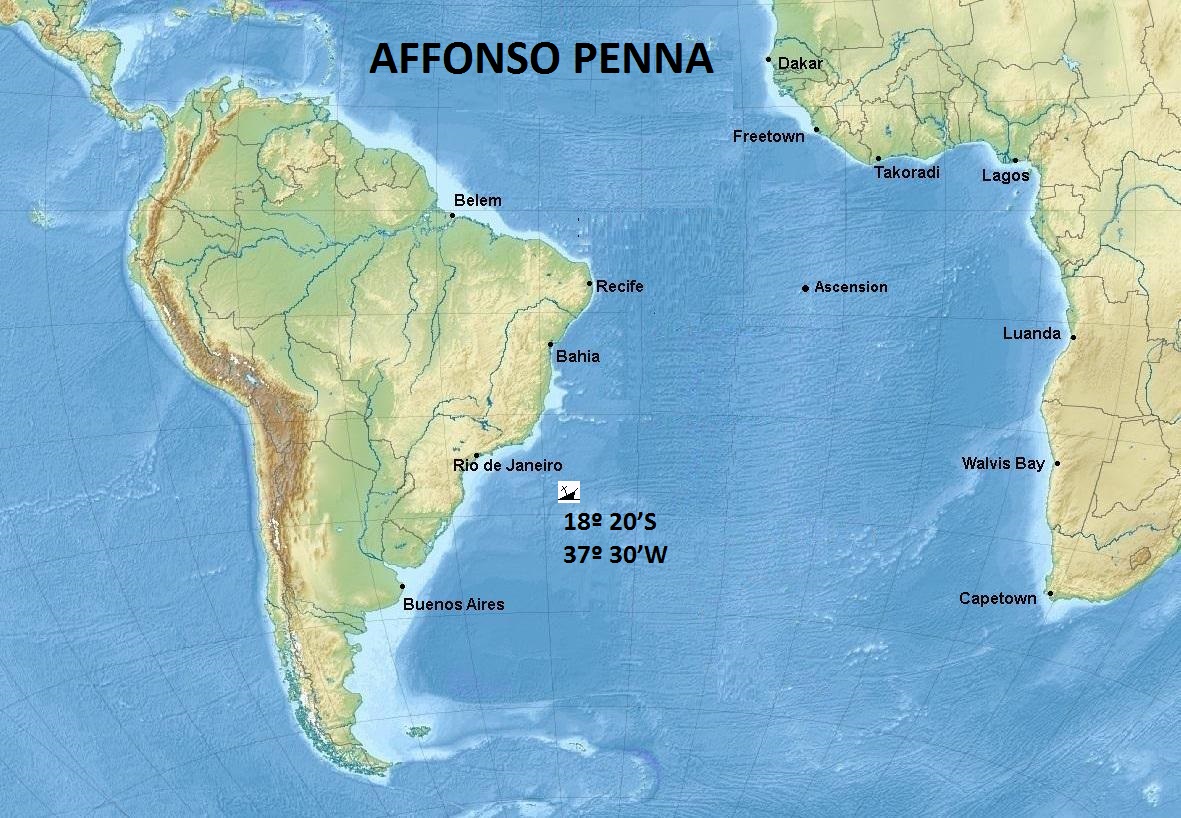
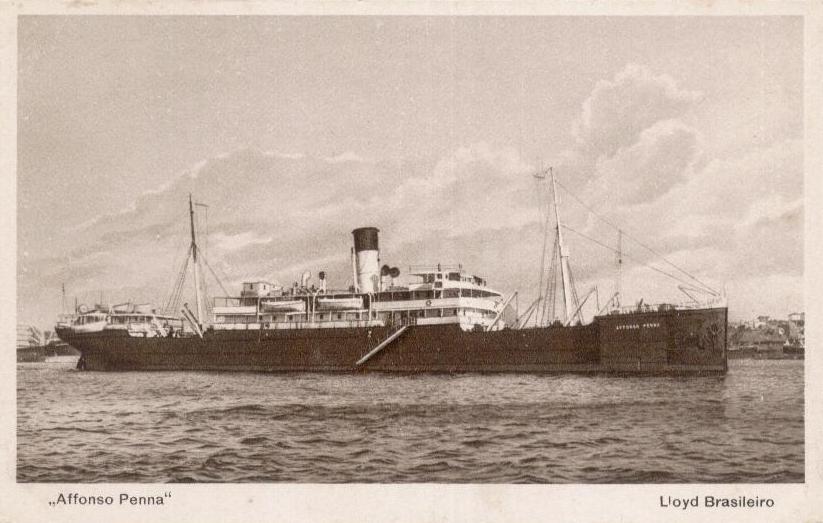

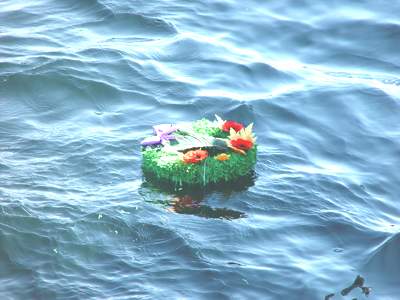
Built: 1910
Tonnage: 3,540 tons
Cargo: Passengers and general cargo.
Sunk 02 MAR 43 by submarine Barbarigo on pos. 18º 20’S 37º 30’W
125 Dead
127 Survivors
In March 1943, took place the second torpedoing of that year. This time the victim was the passenger steamship Afonso Pena, ex Minas Gerais from Brazilian Lloyd. English built in 1910, and with 3540 tons, she departed Recife under Master Euclides Basilio, and formed a convoy of 5 ships escorted by Brazilian cruiser Bahia and two submarine chasers.
Also with Afonso Pena, heading the screen was the tanker Reconcavo, merchant Norteloide, merchant Itape, and one British cargo. With the exception of merchant Itapage, which destined the port of Maceio, all remaining vessels bound for Rio. The convoy initially had to remain off Recife until 09:00AM the following day, 28th, when began making their way past the convoy which numbered 13 foreign ships which sailed on the same southern course.
Thus the group increased in number and in safety, and these 21 ships including 3 insufficient escorts began the long and uncertain journey of 1000 mile plus to the south. Once the motley group had several old ships burning coal that could not take the pace with the modern ones, the Commodore established a mere feasible 7 knots for the convoy. Although it could be attractive to any uboat prowling, they could count on the escorts and their ability to provide an efficient screen and above with Brazilian Air Force squadrons which gave their assistance around the clock helping to stave off any intruder.
At 05:00 PM that same day, the flagship, an American oiler began to maneuver and signaling with flags that Afonso Pena was not able to interpret but with the assistance of a British cargo which sailed along at starboard side with Afonso Pena and requested the latter to repeat for confirmation.
In these circumstances Afonso Pena read the message as 3 next changing of course were planned to be executed during the night: The first at 06:10 PM, the second at 08:10 PM, and the last to be complied at the following day at 01:10AM, on March the 1st. Later already sunset at 06:00PM, the flagship signaled but did not have response from the part of the British cargo as normally done until that time. Steamer Afonso Pena, could read only 3 flags of these signals, which meant that should the convoy came into dispersion, the next position for the following day would be set for point X.
This specific point corresponded exactly to the one emitted by the last signal flag, and could no be read by the steamer due to the distance and poor visibility in the occasion. When the first lights of the dawn disclosed, was Afonso Pena sailing flanked by seven ships which steered the same course out of the reach of the main screen and to worsen the things, without the protection of any escort. In view of that confusion, master Euclides followed the seven ships until noon with the hope that the remaining others from the assembled convoy could join the screen.
For his disappointment, that would not happen and with one more concern to his attributions, the shortage of coal in the bunkers did not recommend to maintain that course, and adding the lack of appropriate nautical charts, so he decided to stay away of the screen and set course for Rio his final destination.
His intended plan, was to sail far off the coast in the supposition of the presence of u-boats lurking those waters off Salvador , Bahia where a convoy was being assembled with 17 merchants loaded with all kind of cargo which meant targets for the wolves. The course fixed by master Basilio, made their way Eastern of Abrolhos archipelago some 100 miles off Bahia.
When plying the waters in darkness of night, at 07:00 PM, at coordinates 17º 10’S 035º 58’W, the ship was struck by violent explosion at portside which hit amidships on hold # 2 and contiguous coal bunker. 3 minutes elapsed when gunshots blown up the radio room and nearby. The radioman, Pedro Cabral was found deadly wounded when desperately tried to sent a SOS and position of his ship. Steamer Afonso Pena plummeted within 15 minutes after the first impact. The task of salvage of the passengers was an ordeal with the ship listing badly to port and all lifeboats on that side rendered useless, while those on the starboard were hit by debris, only one could be lowered where 8 crewmen and one passenger boarded in while the ship was still in motion.
Looking up in the starred sky for the Southern Cross to provide them a certain bearing, they headed to the coast where after 62 hours they sighted the Paschoal hill, the first land to be sighted by Portuguese discoverer of Brazil, Pedro Alvares Cabral, back in 1500. The fishing boat Ganderense picked them and landed all at Porto Seguro. Meanwhile, the remaining survivors began to suffer the desperation of being scattered at sea in complete darkness with fear of being in waters infested by sharks.
Clinging to flotsam they tried to keep afloat in the vain hope any ship of the convoy could have picked up the SOS and diverted one escort to rescue them. Some unending minutes passed when the conning tower of the assailant boat came into view . The men questioned about the ship’s name, her cargo, destination and other relevant information. They also inquired about one particular merchant, the Brazilian cargo Midosi.
One proof that Axis spy ring was efficiently working was demonstrated by that inquiry. Merchant Midosi loaded with vital military cargo was moored at the port of Maceio and awaiting instructions to sail to Rio where the badly needed supply had to be delivered to Brazilian Army. The submarine, very close to the survivors, resembled one of the subs Brazilian Navy had acquired late in 1939 from Italy. With 8 armed sailors at the bridge, muzzle down, while at the tower one searchlight beamed at the survivors and environs.
One man asked in English looking for the master and repeated the same in Italian and Spanish, leading the survivors to believe the boat was an Italian one. Much contributed to the great loss of passengers and crew, the fact that the engines were still running at full steam when the first impact occurred. The fourth machinist panicked and running away did not close the respective boiler; that unfortunate man came to die in one raft amidst stupor and shock. 127 out of 242 crewmembers and passengers managed to survive,17 of them wounded. With the exception of the survivors which ended up at Porto Seguro, the 127 remaining were fished out by the American tanker Tennessee on March the 3rd, and landed them at Rio on the 6th.
Chicago Tribune March 20, 1943.
BRAVE SHARKS
WOMEN REFUSE RESCUE BY SUB
Survivors in Rio Tell How U. S. Ship Saved Them.
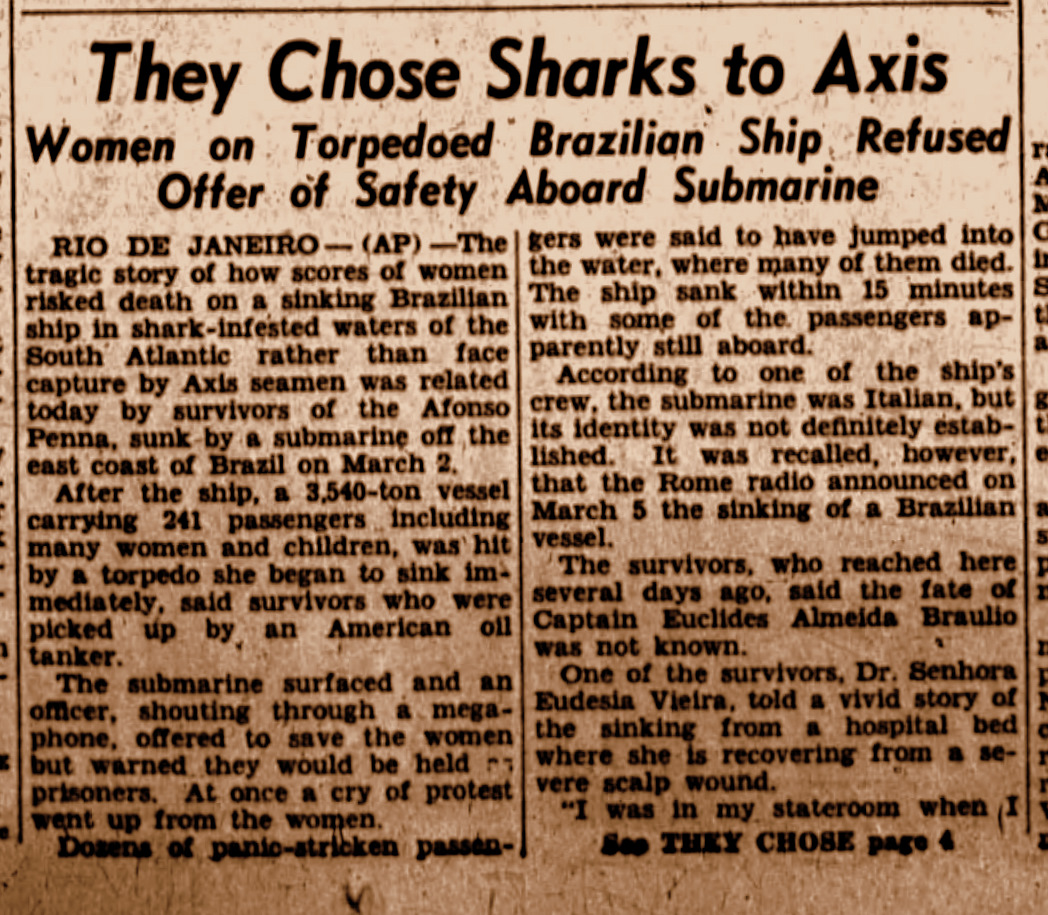
RIO DE JANEIRO, Brazil, March 18-The tragic Story of how scores of women risked death on a sinking Brazilian ship in shark Infested waters of the South Atlantic rather than face capture by axis seamen was related today by survivors of the Afonso Penna, sunk by a submarine off the east coast of Brazil March 2. After the ship, a 3,540 ton vessel carrying 241 passengers, including many women and children, was hit by a torpedo she began to sink immediately, said survivors who were picked up by an American oil tanker . The submarine surfaced and an officer, shouting thru a megaphone, offered to save the women but warned they would be held as prisoners. At once a cry of protest went up from the women. Dozens jumped into water.
Dozens of panic stricken passengers were said to have jumped into the water, where many of them died. The ship sank within 15 minutes with some of the passengers apparently still aboard. According to one of the ship's crew, the submarine was Italian, but its Identity was not definitely established. A reliable informant said 123 persons, Including many women and children, had been listed as missing. One of the survivors, Mrs. Eudesia Vieira, told, of the sinking from a hospital bed, where she is recovering from wounds.
I was in my stateroom when I felt the ship shake as a torpedo struck, she said. The fastest way out seemed to be the porthole, through which some soldiers pulled me. My head was cut badly. We all ran around the deck trying to find lifeboats and rafts. When the ship was almost down I jumped off beside a raft which had been thrown into the water and clambered onto It. Some men already were on the raft and they wound a cloth around my head, which was bleeding badly.
Amputation with Table Knife.
Swimming close by was Corp. Joao Fausto, who had been on his way to enter a medical school here at Rio de Janeiro. We pulled him aboard the raft and saw that his left foot was dangling just by a muscle. The ship's doctor was on a nearby raft and the corporal asked him to cut off the foot. Somebody had an ordinary dull table knife which the doctor used for the amputation. The boy lay on the raft deliriously talking of his mother and saying he didn't mind dying like a soldier. Three hours later he died.
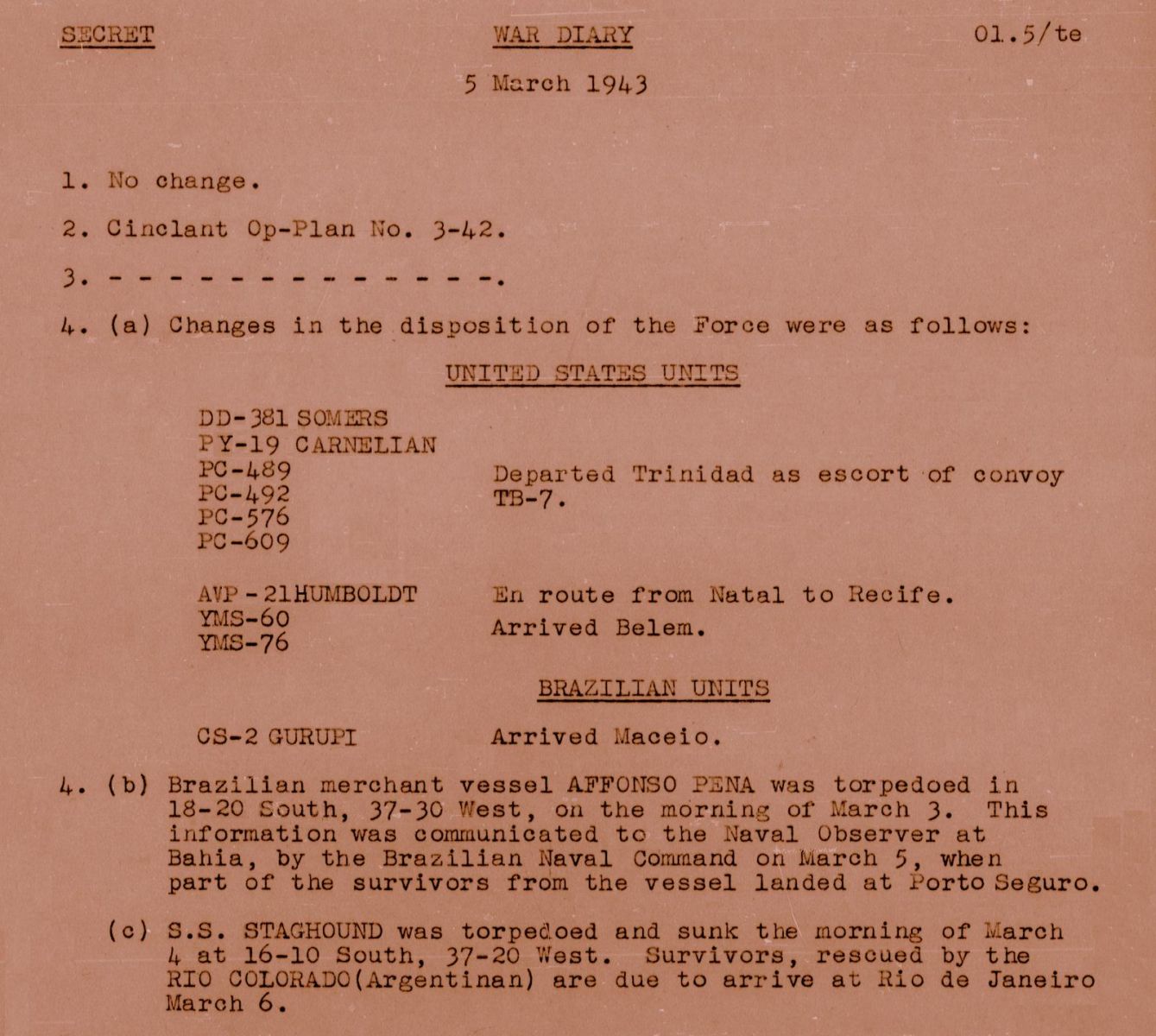
Above a secret message from Commander in Chief Atlantic (CINCLANT) reporting the sinking of AFONSO PENA
